
The Horseley Bicycle Company had premises in Horseley
Fields. Around the end of the 19th century they produced 'Horseley'
safety bicycles and tricycles. The following photographs
were taken from Hulley's Directory of 1889.
|
|
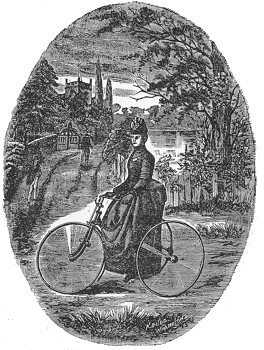
The 'Invicta' tricycle. |
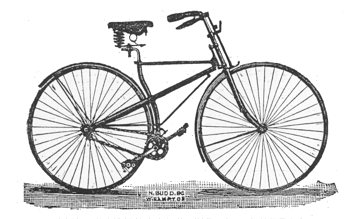 |
The 'Horseley Number 1' Safety
bicycle. |
| The following is a short
description from "Bicycles & Tricycles of the Year 1889" by
Harry Hewitt Griffin:
The Horseley No.1 Spring-frame Dwarf Safety Roadster.
Horseley Cycle Company, Wolverhampton. Spring forks form
a special feature of the machine; these are shown in the
image below. The fork foot, instead of running direct to the
axle, curves out a little above and beyond it; to a stud on
the end is pivoted a short link, also pivoted on the axle
end. With only this connection, the fork would of course
drop down; but to restrain this, and receive the weight,
there is, between this and a small elbow at the back of the
fork, a strong coil spring. Any concussion on the front
wheel drives it backward, and these springs compressing,
they absorb the shock, and relieve the rider of a great
amount of vibration. The frame is a single cross one, but
there is a very strong stay from the top of the seat-pillar
to the neck; a strong lower stay also runs down from a lug
on the backbone to the bearing bracket. There are, in
addition, the usual back stays. Rudge ball bearings are put
to all parts; wheels, both 30in., with tangent spokes,
crescent rims, and tin. rubbers. The handlebar is curved
back considerably, with 'T' grips. The machine may be relied
on as a good one. Price £18; or with hollow felloes,
£18.15s.

The Horseley No.1 Spring-frame Dwarf
Safety Roadster.
The Horseley No.2 Dwarf Safety Roadster.
A cheaper pattern of the same type, without either the
spring forks or upper stay; but the lower stay is in a
better position, as it runs right up to the bottom of the
solid neck. It also has ball bearings all round,
¾in. red rubbers, solid
rims, etc.; and the price is £13; or with hollow felloes,
£13.15s.
The following
description of a Horseley tricycle is also from "Bicycles &
Tricycles of the Year 1889" by Harry Hewitt Griffin:
The Horseley Invicta Direct Steering
Roadster. The Horseley Cycle Company, Horseley Fields,
Wolverhampton). There are a few alterations from the
general model of the direct-steerer. From the centre of the
four-bearing axle bridge, the main connecting tube slants
down, and then curves up to the neck and centres of the
front steering-pillar. At the back, the seat-pillar tube
starts from above the central tube, curves forward, and is
supported by stout stays to above the bend of the main tube,
and is then perpendicular for the 'Γ'
pin. This stay greatly strengthens the frame, and,
being low down,
does not interfere with a lady using the machine. To the
curved front forks are fitted the spring joints (when
ordered) that are so successfully applied to the dwarf
safety bicycle turned out by the same firm. They remove a
very large percentage of the vibration, making the holding
of the handlebar far less tiring. The standard size of the
wheels is 32in. rear and 30in. front, with
¾in. rubbers, solid
rims, and tangent or direct spokes, an open choice. The
machine is a good one, and the list price is £23; if built
light, with hollow rims, etc., £24.5s. The brake is a lever
plunger to the front wheel. |
Hough
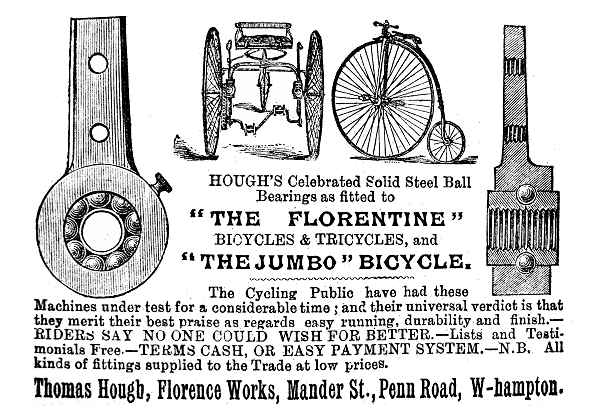
|
Howard
Howard bicycles were produced by Mr. Fred C. Poyner in his
shop premises at 539 and 540 Dudley Road. The business was established in
1905 and Mr. Poyner undertook all kinds of cycle and motorcycle repairs,
running a 24 hour repair service that catered for private individuals and
the trade. He sold all kinds of cycle parts and accessories, and the City
Cycling Club held meetings at the shop. Fred was a keen Wolves supporter and
at one time he supplied the football club with its strip.
|

Poyner's Cycle Shop in 1921.
|
Hughes
The following is a
short description from "Bicycles & Tricycles of the Year
1889" by Harry Hewitt Griffin:
The Homo No.1 Dwarf Safety Roadster. G.
Hughes, Temple Works, Temple Street, Wolverhampton.
This machine has the popular divided diamond frame, which
has, with the exception of the top front upper stay, double
tubes all round, with central stays, the bearing-bracket
being well supported. Extra long cranks are fitted, and, the
saddle being in a good position, the rider can put forth his
full power. The steering-rod is curved a good deal, and has
'T' handles. There is a plunger brake, and the machine is
well and strongly built throughout. Usual details, balls all
parts, etc., list price, £13. There is a No.2, plainer
details and a skeleton diamond frame, etc., at £10.10s.
Humber
Humber & Company Limited was founded by Thomas Humber at
Beeston, Nottinghamshire, in 1869. In 1887 Joseph Devey sold his
cycle manufacturing business at Ashes Works, Pelham Street, Wolverhampton to Mr. Joseph Horton
of Birmingham for £10,000. Mr. Horton also purchased the Coventry
Cycle Company Limited and Humber & Company and joined them
together to form Humber & Company Limited. Humber cycles
were soon being produced at Ashes Works, also known as Tower Works. On 8th March, 1900
the business became Humber Limited and production moved to
Coventry. |
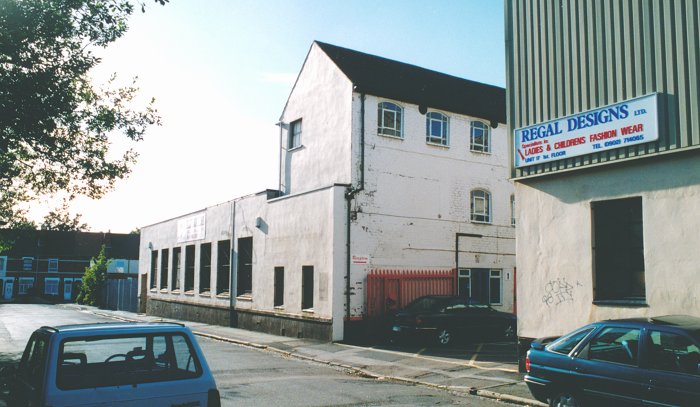 Ashes Works, as seen in 2,000. It has since been
demolished.
Ashes Works, as seen in 2,000. It has since been
demolished.
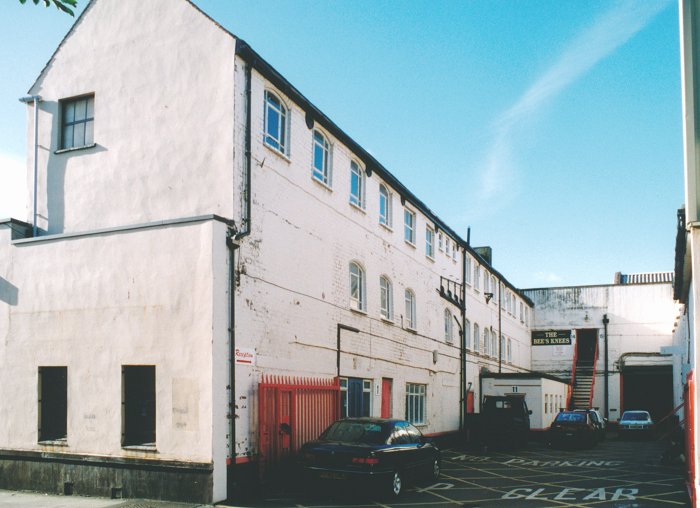
Another view of Ashes Works. Also called Tower
Works.
|
Humber also had a factory in Great Brickkiln
Street, Wolverhampton, possibly the rear part of Ashes Works. In 1896 the company acquired a
factory in Pountney Street, and also had showrooms in Queen
Street. Humber later built a new works at Stoke in Coventry,
and in 1900 production moved there. Ashes Works closed and
remained empty until it was sold to Clyno in 1912, and the
Pountney Street factory was later taken over by cycle makers
Sharrett & Lisle. In 1877 Humber went into
partnership with Marriott and Cooper. This was not to last. Marriott and Cooper started producing and selling their
own Humber bicycles. These were made in Wolverhampton by Dan Rudge. At this time Humber called its cycles 'Genuine
Humber' cycles to distinguish them from Marriott and
Cooper's products. |
|
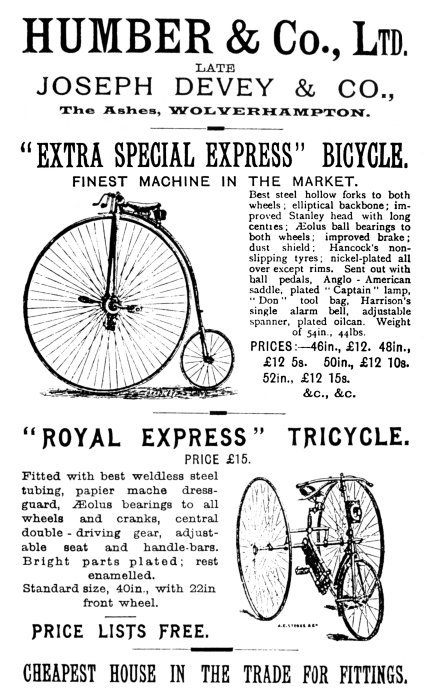
Courtesy of Jim Boulton. |
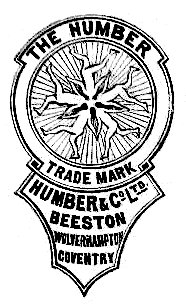 |

An advert from 1898.
| Some products from the early
1890s: |
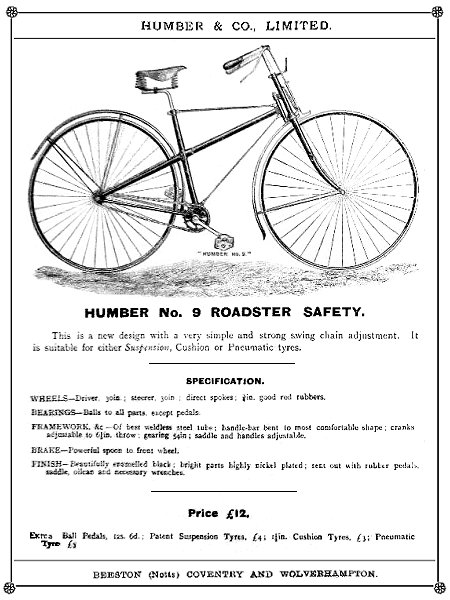
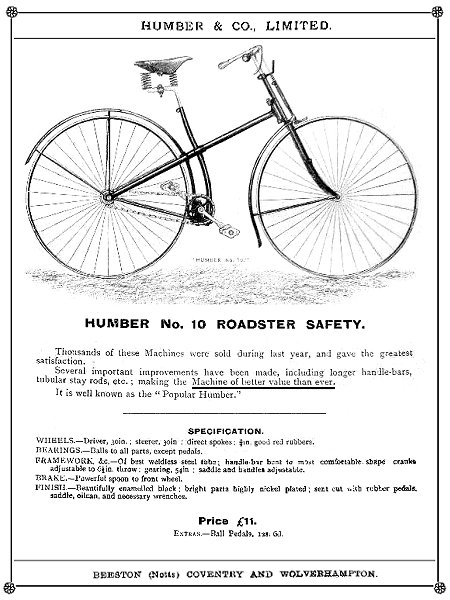
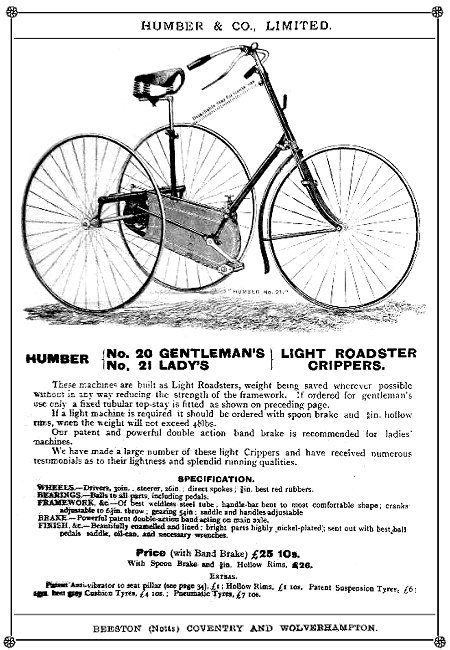
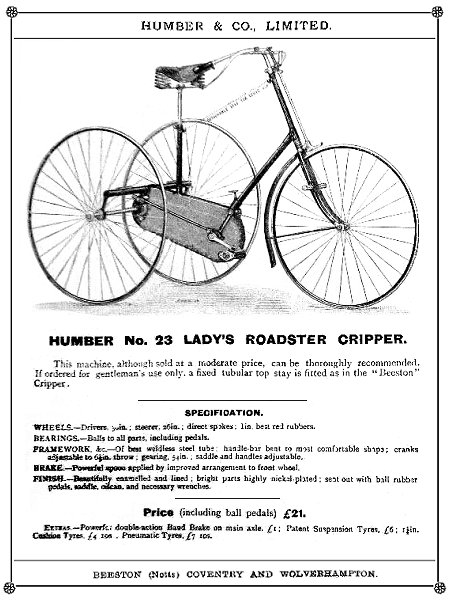
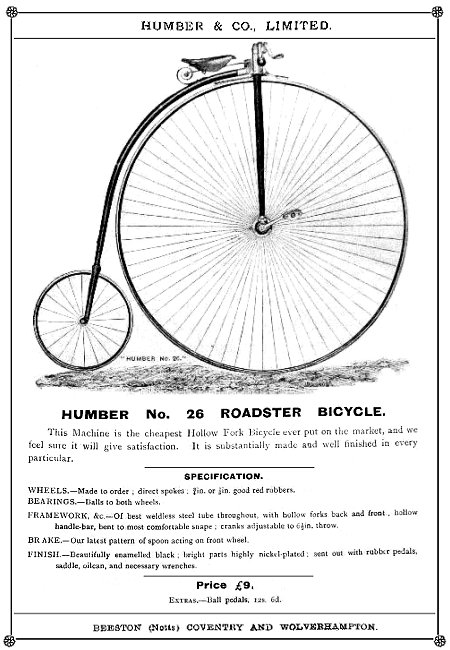
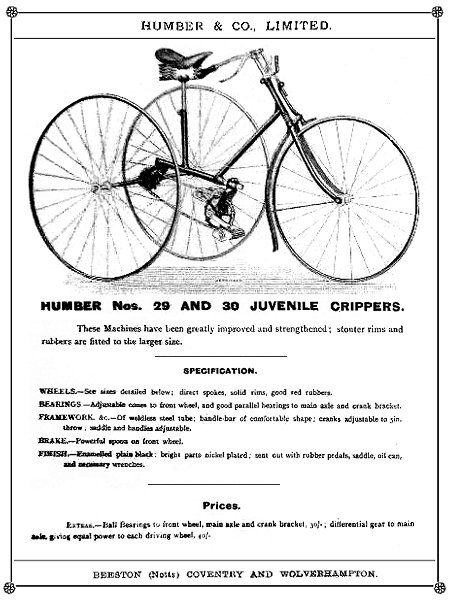
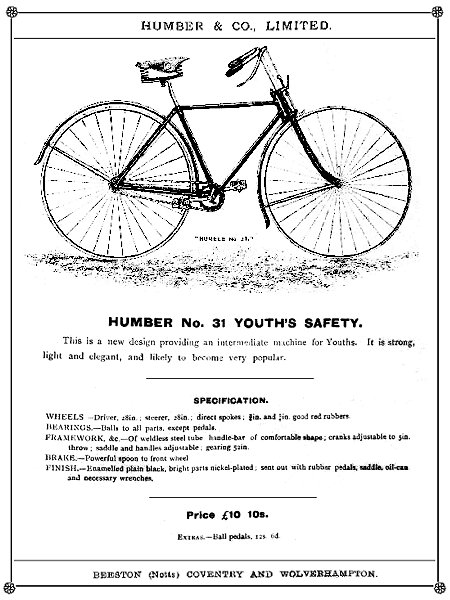
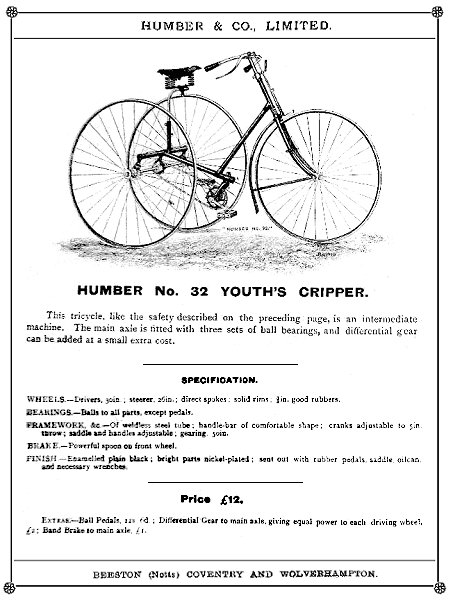
Jackson & Beeston
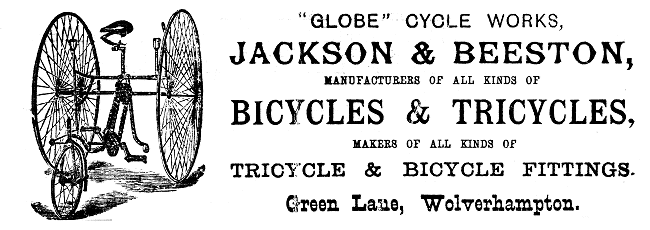
|
Thomas
Lisle
In 1868 a cycle catalogue was produced by Mr. Thomas Lisle who had a
factory at Villiers street, Moorfields, Wolverhampton. Thomas was the
uncle of Edward Lisle who founded Star.
In 1858 he produced Japanned hardware and by 1861 worked as a clerk for
Henry Fearncombe & Co.
His early machines were a ‘French Bicycle’, a ‘German Tricycle’, and a
‘Ladies Velocipede’. The ‘French Bicycle’ and the ‘German Tricycle’ were
based on the ‘Michaux Velocipede’.
The ‘Ladies Velocipede’, a treadle operated tricycle had treadles that
were connected by levers to cranks on the rear axle. Other features
included a padded seat and tiller steering. He also produced a special
‘Postman’s Tricycle’ for rural postman that sold for 35 shillings. |
|
Harry Lester
 |
William Lewis
| This advert is from the
programme for the Wolverhampton Art and Industry Exhibition of 1884. |
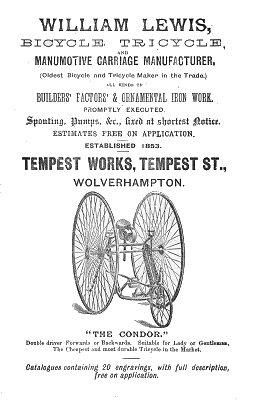 |
|
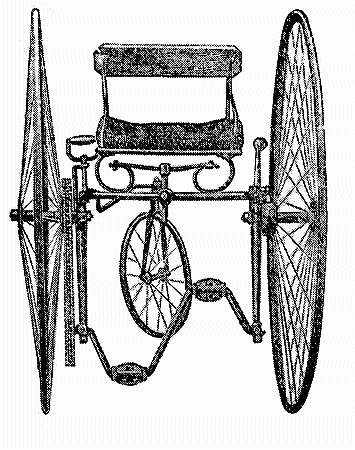
A machine made by William Lewis in
1884. |
William Lewis's business was established in 1853, and he
proclaimed himself to be the oldest maker in the trade. If
he started in the cycle business he would have been making
hobby horses, as that's what were produced at the time. |
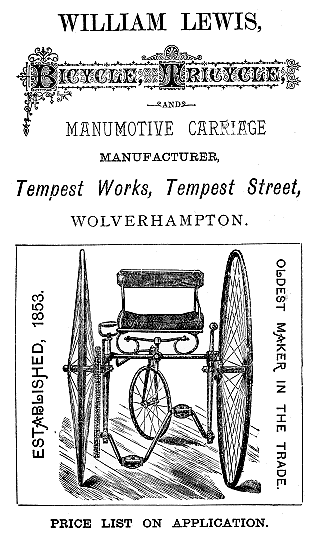
An advert from 1884.
Lloyd and Company
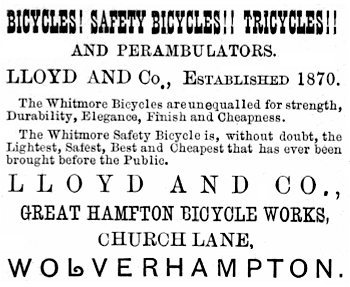 |
An advert from about 1890. |
|
Melbourne
Allan and
Somerfield made the 'Melbourne' cycle at their Melbourne
Street works. They produced a complete range of machines.
|
Mercury

|




